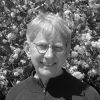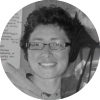The Human Brain: A Model for Decision Making
“The Human Brain as a Model for Decision-Making” is the title of Dr. Maxwell’s talk. He explores how the brain receives and processes information and proceeds to action. Relates Einstein’s theory of time in relation to all created matter. Describes how the “bureau” was the primary change agent in Western development, over the farm and the factory. Maxwell describes nine propostions that help to visualize the brain metaphorically. “Knowledge is evolutionary as the brain is cybernetic.”
Indigenous Perspective on Education for Peace
Ms. LaBlanc is a Native American. She points out that indigenous people are rooted in their culture and therefore their approach to peace is from that perspective. She relates stories from her grandmother who gave her the knowledge to “dance to the rhythm of the earth.” One step most indigenous people must take first is to anger—anger against the injustices they have endured. After that can come re-education to nobility. She closes with this quote attributed to ‘Abdu’l-Baha: “As ye have faith so shall your powers and blessings be.”
The Baha’i Commitment to Unity & Peace
Dr. DeArujo explains that young people, women and children are in a prime position to influence the peace process. The Bahá’í Writings provide overwhelming evidence of the Bahá’í communities commitment to unity and peace. Gives three approaches youth can use to promote the peace process. Youth also need to focus on the Bahá’í principle of the harmony of science and religion. The Bahá’í Office at the United Nations gave special attention to the advancement of women in Bahá’í communities and shared this information with other non-governmental organizations.
Education for Development
Dr. Eyford develops a continuum on which change takes place. He focusses on the social aspects of change. He describes five ways in which change, or development takes place in society. Violence, legislation or laws, public participation, education and culture are these five. Dr. Eyford uses “culture” for “spiritual” because it is less well understood by the general public.
Marriage of Equals: Love & Power
The world of today is beset with problems. Every family member has an impact on the family. A healthy marriage is crucial to a good family life. Sometimes one partner or the other feels beaten down; or he or she may fall in love with someone else; financial issues may test a marriage; etc. Marriage survives and thrives when the individuals find mutual attraction and mutual satisfaction. When these two combine, mutual attraction and mutual satisfaction, the bonds of marriage remain strong and firm.
A New World Order
Mr. Vattachi, deputy-director of UNICEF, and not a Bahá’í, takes as the text for his talk, this quotation from Shoghi Effendi's World Order of Baha'u'llah: "It is towards this goal—the goal of a new World Order, Divine in origin, all-embracing in scope, equitable in principle, challenging in its features—that a harassed humanity must strive.” He continues with these questions: “What is it that divides humanity?
Poetry & Self-Transformation
[The poet, Roger White, has suffered a heart attack. His paper “Poetry and Self-Transformation” is read by Jan Tye-Chew.] Art not only transforms its creator but also its audience. Reading from his paper: “My non-Bahá’í friends who are poets frequently complain that among friends and members of their families to whom they show their work they encounter indifference, contempt, embarrassment, or sometimes hostility, which heightens their sense of alienation and uselessness. They are made to feel frivolous and somewhat less than respectable.
Children’s Public Speaking project: Comparative Religion
Knight of Baha'u'llah, Gayle Woolson teaches public speaking to Baha'i youth. She begins by introducing each of the children who will speak about a diferent Manifestation of God. The children, and the order of speaking, are Ashly Rogers, age 9: Bhram Paitobi, age 11, Janell Roberts, age 10 and Janey Roberts, age 8.
Evolving Understanding of the Baha’i Teachings
Robert Stockman’s talk is “The Bahá’í Faith: Evolving Understandings of its Basic Teachings.” Compared to Christianity and Islam, which are each based on a single book, the Bahá’í Faith has over 60,000 documents of sacred scripture. Stockman details four phases Bahá’ís have gone through in understanding their religion. Stockman’s emphasis is primarily upon the understanding of the North American Bahá’ís. Dr.
Sacred Metaphor
Mr. Blanding’s talk is on “Sacred Metaphor”. The subject of the presentation is a “universal semantic structure” which is found in the world’s major sacred scriptures. It produces a new language tradition in each case. “It connects individual consciousness with the Sacred Power of Creation.” He describes the three-fold structure of a sacred metaphor. He closes with this quotation of Rumi: “Cleanse thou the rheum from out thine head and breathe the breath of God instead.”
Health in a New World Order
“This paper will express a strong connection between spiritual development and the promotion of health." Behavior change in successful health promotion programs is a vital element. The Bahá’í teachings on the organic inter-relationship between soul and body are useful models. Awareness, information, motivation, information, adoption and maintenance are five steps used in the Stanford program for a cardio-vascular improvement. These can be adopted for use elsewhere in a Bahá’í context for “real mass conversion”.
Baha’i Youth & Sexuality
Dr. Sharon Hatcher, MD and Dr. Andrew Kennedy, MD jointly share this presentation on the issue of Bahá’í youth and sexuality from the perspective of the Bahá’í teachings. They alternate throughout. Dr. Kennedy gives background data to set the stage. In 1984 a study of 3,600 teenagers from 180 Canadian schools yielded some striking information about premarital intercourse. Some fifty percent of teenagers in the 15-19 age group had premarital intercourse. Some strategies for dealing with Bahá’í youth on this issue are offered.
Male Reproductive Responsibility
Unknown female from the Orange County California Urban League was asked to write a proposal for the study of the "Male Reproductive Responsibility". She explains that the Urban League focuses on helping urban minorities and the economically disadvantaged. She decided to explore pregnancy and teen fathers because so little research had been done on them. She discovered that one in ten teenage girls becomes pregnant every year. Adolescent male fathers need to accept more responsibility for their role in unwanted pregnancies. She then offers some options that might be pursued.
Youth, Being & Becoming
The second is Dr. Sharon Hatcher. The focus of these presentations is on “being” and “becoming” in the spiritual growth of an individual. And then what role does “being” and “becoming” play in the growth process of society. As everyone is in the process of becoming we are either growing or decaying. “Becoming” can happen in three different ways. Shall we be inner directed or outer directed? Dr. Hatcher is next and her emphasis is upon the practice of spiritual discipline by youth. Afterward the audience is invited to join in the discussion.
Youth & Service to Mankind
Jack Matthews talks about the experiments related to children who are optimistic and pessimistic. He also recalls his youthful experience with Kurt Hahn, who is the founder of his school. Optimism with mental stamina is a good combination. Youth who possess it can be trusted and given responsibility and they will grow from this experience. Of course, war is worst human condition but there some can grow from the experience. There is more service in helping the other people than any other service possibilities. Young people respond to reality and to people’s needs.
Emancipation Training Center
Susan Rosenberg presents the model that her agency uses to prepare youth to live on their own. She feels this model can also be used by any Bahá’í community or even your own family for that matter. Susan has the audience put themselves into the shoes of a 15 year old and the problems he or she might be confronting. She explains the thought processes a child goes through in dealing with work issues and financial situations. In Ms. Rosenberg’s daily work six years of developmental growth are compressed it into four months for each child. The county will only pay for four months.
From Copper to Gold
Dorothy Freeman, the granddaughter of Hand of the Cause of God Dorothy Baker, presents “The Life of Dorothy Baker”, based on her recent biography From Copper to Gold. She explains why her book is not constructed like a typical biography and uses quotations from the prayer for the Hands to show us what we should strive for in our own lives. Tells stories about Dorothy’s husband, Frank Baker and how he treated Louis Gregory when Louis visited Lima, Ohio. At the close Dorothy Freeman takes questions from the audience about her book.
Doukhobors & The Baha’i Faith
Dr. Ghadirian talks about one of the minorities in Canada, the Doukhobor. The Doukhobor who are precious, rural, peace-loving people have had to face many challenges. The beloved Guardian has spoke of the Doukhobor. Dr. Ghadirian outlines their origin and their philosophy. He described the Doukhobor Movement as an historical parallel with the Bahá'í Faith. The Doukhobor are a group of Russian pacifists who are migrated to Canada early in the 19th century. The word Doukhobor means "Spirit Wrestlers"; they are part of Spiritual Christianity.


















